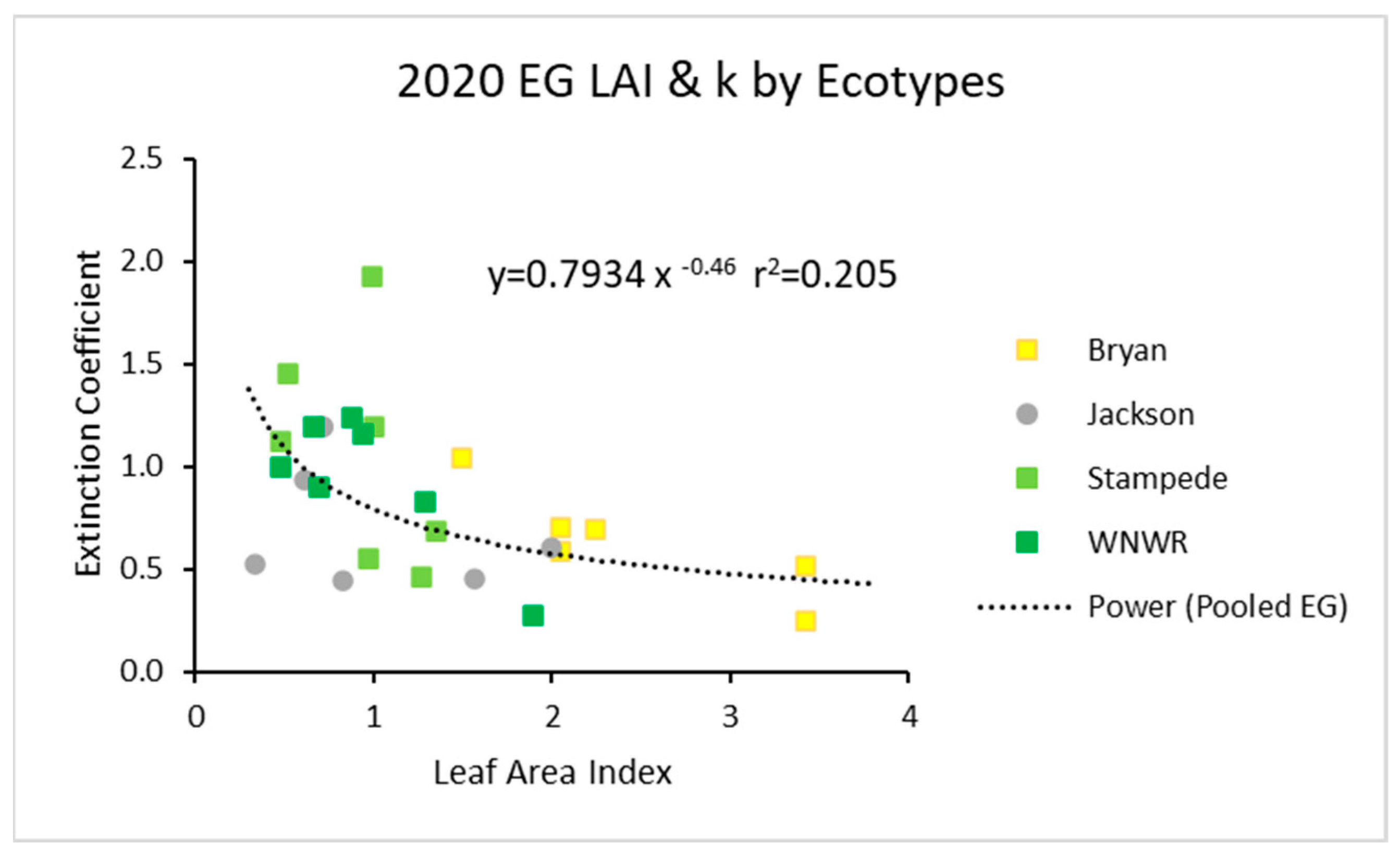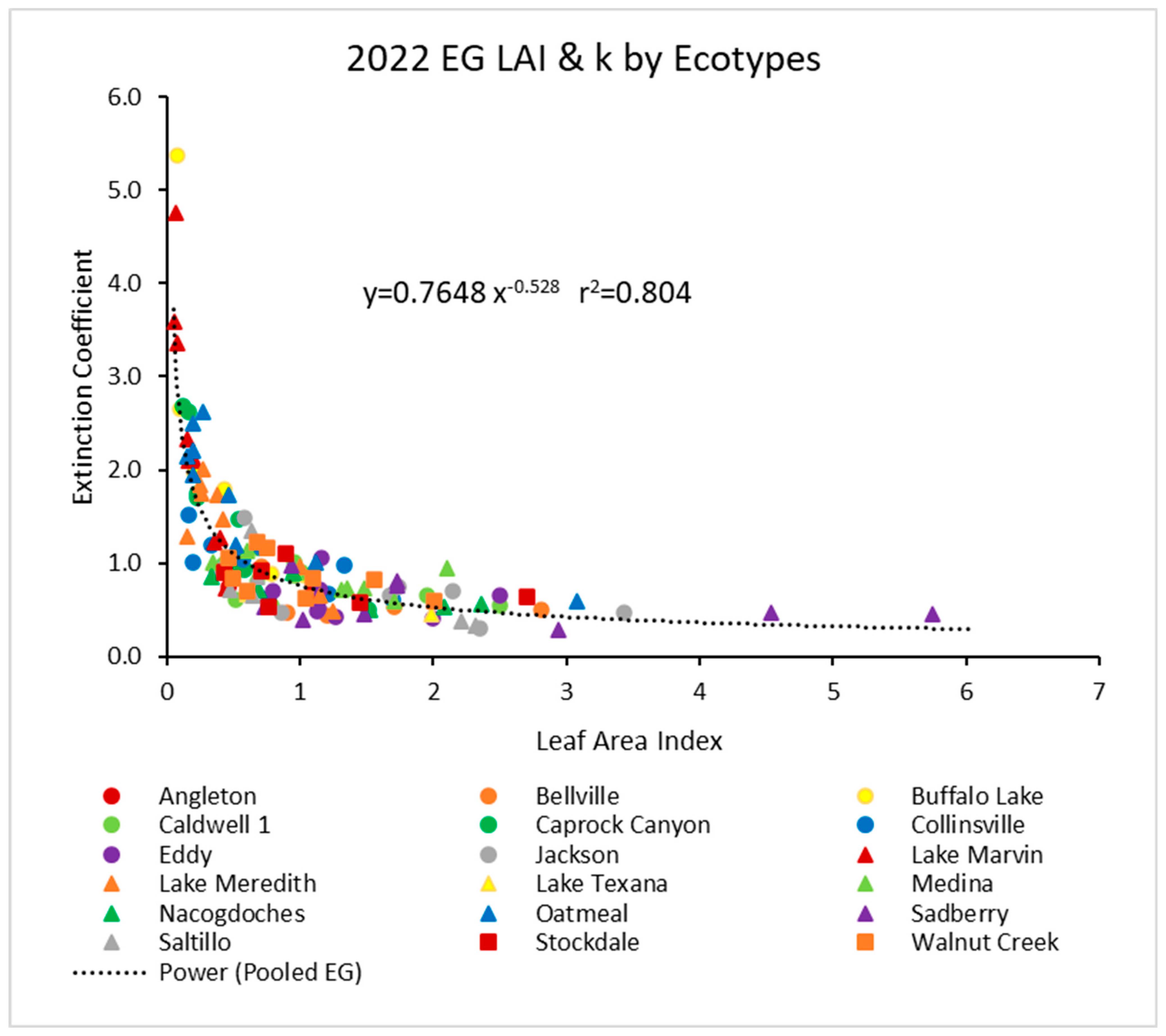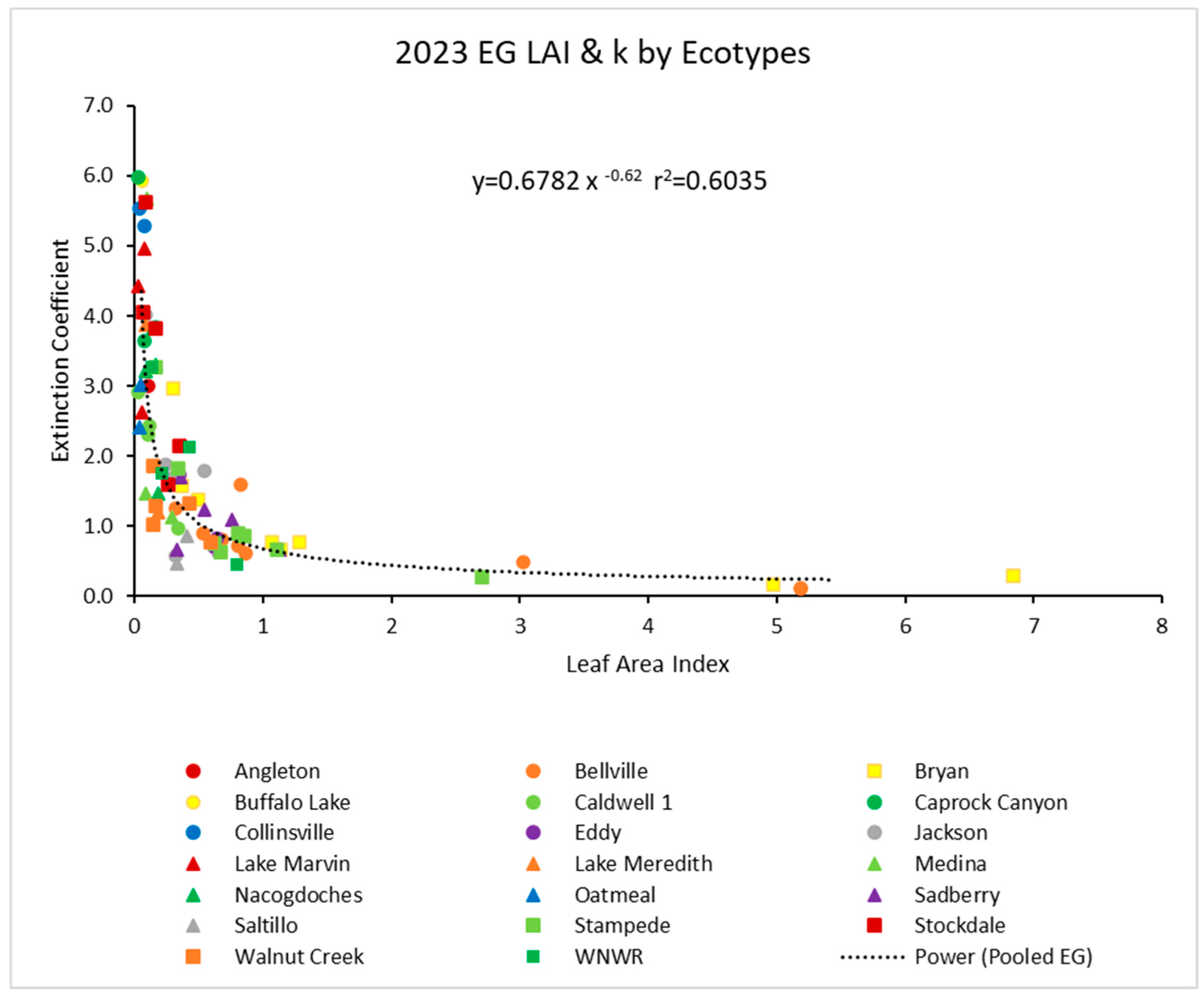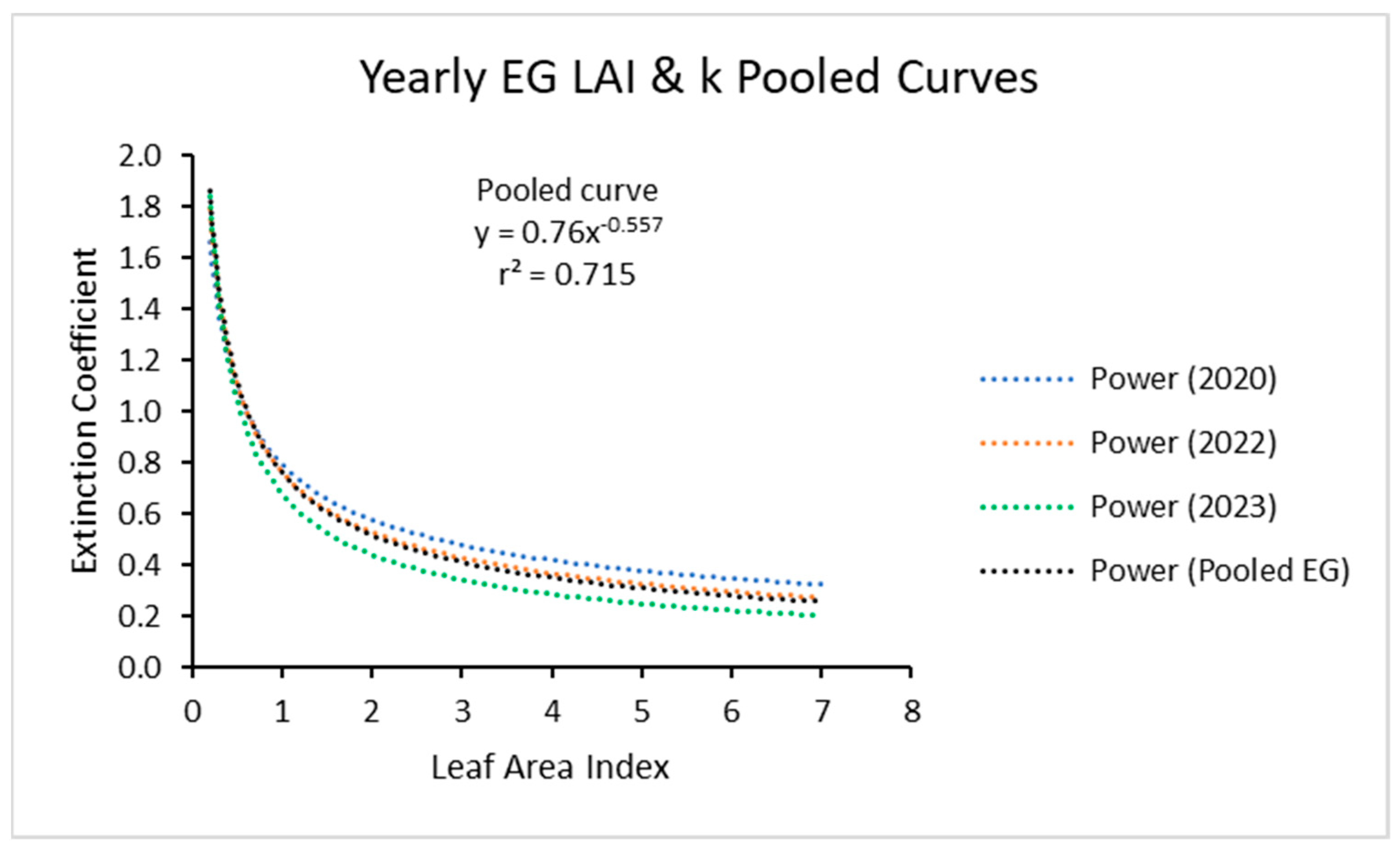Eastern Gamagrass Model Simulation Parameters for Diverse Ecotypes: Leaf Area Index, Light Extinction Coefficient, and Radiation Use Efficiency
Abstract
:1. Introduction
2. Materials and Methods
3. Results
3.1. LAI and k
3.2. RUE
4. Discussion
4.1. Other Species for Comparision
4.1.1. Coastal Bermudagrass
4.1.2. Switchgrass
4.1.3. Maize
5. Conclusions
Author Contributions
Funding
Data Availability Statement
Acknowledgments
Conflicts of Interest
Appendix A
| Name | City | County | State | Latitude | Longitude | Avg Annual Precipitation (mm) | Avg Annual Temperature (°C) | Soil | Ploidy |
|---|---|---|---|---|---|---|---|---|---|
| Angleton | Angleton | Brazoria | TX | 29.176208 | −95.404211 | 1092–1245 | 19–22 | Lake Charles clay | 2× |
| Bellville | Bellville | Austin | TX | 29.910744 | −96.250814 | 864–1320 | 17–21 | Trinity clay, frequently flooded | 2× |
| Bryan | Bryan | Robertson | TX | 30.743083 | −96.497133 | 864–1016 | 19–21 | Highbank silty clay loam, rarely flooded | 3× |
| Buffalo Lake | Buffalo Lake | Randall | TX | 34.908367 | −102.149536 | 406–559 | 13–17 | Portales clay loam | 3× |
| Caldwell 1 | Caldwell | Washington | TX | 30.12613592 | −96.60179283 | 711–1016 | 18–21 | Bosque clay loam, frequently flooded | 4× |
| Caprock Canyon | Caprock Canyon | Briscoe | TX | 34.417217 | −101.071383 | 508–584 | 14–18 | Berda loam | 4× |
| Collinsville | Collinsville | Cooke | TX | 33.55500 | −96.94590 | 711–1016 | 18–21 | Gowen clay loam | 4× |
| Eddy | Eddy | McLennan | TX | 31.29945 | −97.248933 | 762–1067 | 18–20 | Fairlie clay | 2× |
| Jackson | Edna | Jackson | TX | 28.90000 | −96.53000 | 940–1244 | 21–22 | Laewest clay | 4× |
| Lake Marvin | Lake Marvin | Hemphill | TX | 35.887864 | −100.179944 | 457–635 | 14–17 | Sweetwater soils, frequently flooded | 3× |
| Lake Meredith | Lake Meredith | Potter | TX | 35.591725 | −101.726786 | 508–711 | 16–18 | Clairemont silty clay loam, occasionally flooded | 4× |
| Lake Texana | Lake Texana | Jackson | TX | 29.058933 | −96.579483 | 965–1118 | 21–22 | Navidad fine sandy loam, frequently flooded | 4× |
| Medina | Hondo | Medina | TX | 29.37844 | −99.12653 | 584–762 | 21–22 | Divot clay loam, occasionally flooded | 4× |
| Nacogdoches | Nacogdoches | Nacogdoches | TX | 31.65000 | −94.53333 | 1016–1168 | 18–20 | Alto fine sandy loam | 4× |
| Oatmeal | Oatmeal | Burnet | TX | 30.6882 | −98.0909 | 762–914 | 18–20 | Bolar clay loam | 4× |
| Sadberry | Sadberry | Robertson | TX | 30.765683 | −96.507133 | 838–1016 | 19–21 | Hearne fine sandy loam | 3× |
| Saltillo | Saltillo | Hopkins | TX | 33.22733 | −95.33601 | 1016–1321 | 18–21 | Nahatche soils, frequently flooded | 4× |
| Stampede | Stampede | Bell | TX | 31.28295 | −97.44733 | 762–965 | 18–19 | San Saba clay | 2× |
| Stockdale | Stockdale | Wilson | TX | 29.238056 | −97.983056 | 660–864 | 21–23 | Leming loamy fine sand | 4× |
| Walnut Creek | Walnut Creek | Robertson | TX | 31.01645 | −96.705033 | 864–1016 | 18–20 | Zilaboy clay, frequently flooded | 4× |
| WNWR1 | Meers | Commanche | OK | 34.74290 | −98.62850 | 787–1016 | 14–17 | Brico soil and Rock outcrop | 2× |
| Common garden | Temple | Bell | TX | 31.045492 | −97.348125 | 838–1092 | 17–17 | Houston Black clay | NA |
References
- Kiniry, J.R.; Williams, A.S.; Jacot, J.; Shadow, A.; Brakie, M.; Burson, B.; Jessup, R.; Cordsiemon, R.; Kim, S.; Avila, A.; et al. Diverse eastern gamagrass ecotypes: General characteristics, ploidy levels, and biogeography. Crop Sci. 2023, 63, 3545–3556. [Google Scholar] [CrossRef]
- Ahring, R.M.; Frank, H. Establishment of eastern gamagrass from seed and vegetative propagation. J. Range Manag. 1968, 21, 27. [Google Scholar] [CrossRef]
- Springer, T.L.; Dewald, C.L. Eastern gamagrass and other Tripsacum species. In Warm-Season (C4) Grasses; Moser, L.E., Burson, B.L., Sollenberger, L.E., Eds.; Agronomy Monographs: Madison, WI, USA, 2004; Volume 45. [Google Scholar]
- Gillen, R.L.; Berg, W.A.; Dewald, C.L.; Sims, P.L. Sequence grazing systems on the Southern Plains. J. Range Manag. 1999, 52, 583–589. [Google Scholar] [CrossRef]
- Blanco-Canqui, H. Growing dedicated energy crops on marginal lands and ecosystem services. Soil Sci. Soc. Am. J. 2016, 80, 845–858. [Google Scholar] [CrossRef]
- Clark, R.B.; Alberts, E.E.; Zobel, R.W.; Sinclair, T.R.; Miller, M.S.; Kemper, W.D.; Foy, C.D. Eastern gamagrass (Tripsacum dactyloides) root penetration into and chemical properties of claypan soils. Plant Soil 1998, 200, 33–45. [Google Scholar] [CrossRef]
- Gilker, R.E.; Weil, R.R.; Krizek, D.T.; Momen, B. Eastern gamagrass root penetration in adverse subsoil conditions. Soil Sci. Soc. Am. J. 2002, 66, 931–938. [Google Scholar] [CrossRef]
- Keyser, P.D.; Lituma, C.M.; Bates, G.E.; Holcomb, E.D.; Waller, J.C.; Griffith, A.P. Evaluation of eastern gamagrass and a sorghum × sudangrass for summer pasture. Agron. J. 2020, 112, 1702–1712. [Google Scholar] [CrossRef]
- Rhoades, E.D. Inundation tolerance of grasses in flooded areas. Trans. ASAE 1964, 7, 164–0166. [Google Scholar] [CrossRef]
- Kiniry, J.R.; Williams, J.R.; Gassman, P.W.; Debaeke, P. General Process-Oriented Model for Two Competing Plant Species. Trans. Am. Soc. Agicultural Eng. 1992, 35, 801–810. [Google Scholar] [CrossRef]
- Behrman, K.D.; Keitt, T.H.; Kiniry, J.R. Modeling Differential Growth in Switchgrass Cultivars Across the Central and Southern Great Plains. BioEnergy Res. 2014, 7, 1165–1173. [Google Scholar] [CrossRef]
- Kiniry, J.R.; Johnson, M.V.V.; Venuto, B.C.; Burson, B.L. Novel Application of ALMANAC: Modelling a Functional Group, Exotic Warm-season Perennial Grasses. Am. J. Exp. Agric. 2013, 3, 631–650. [Google Scholar] [CrossRef]
- Kiniry, J.R.; MacDonald, J.D.; Kemanian, A.R.; Watson, B.; Putz, G.; Prepas, E.E. Plant growth simulation for landscape-scale hydrological modelling. Hydrol. Sci. J. 2008, 53, 1030–1042. [Google Scholar] [CrossRef]
- Kiniry, J.R.; Sanderson, M.A.; Williams, J.R.; Tischler, C.R.; Hussey, M.A.; Ocumpaugh, W.R.; Read, J.C.; Van Esbroeck, G.; Reed, R.L. Simulating Alamo switchgrass with the ALMANAC model. Agron. J. 1996, 88, 602–606. [Google Scholar] [CrossRef]
- Kiniry, J.R.; Muscha, J.M.; Petersen, M.K.; Kilian, R.W.; Metz, L.J. Short Duration, Perennial Grasses in Low Rainfall Site in Montana Deriving Growth Parameters and Simulating with a Process-Based Model. J. Exp. Agric. Int. 2017, 15, 1–13. [Google Scholar] [CrossRef]
- Kiniry, J.R.; Burson, B.L.; Evers, G.W.; Williams, J.R.; Sanchez, H.; Wade, C.; Featherston, J.W.; Greenwade, J. Coastal Bermudagrass, Bahiagrass, and Native Range Simulation at Diverse Sites in Texas. Agron. J. 2007, 99, 450–461. [Google Scholar] [CrossRef]
- Kiniry, J.; Cassida, K.; Hussey, M.; Muir, J.; Ocumpaugh, W.; Read, J.; Reed, R.; Sanderson, M.; Venuto, B.; Williams, J. Switchgrass simulation by the ALMANAC model at diverse sites in the southern US. Biomass Bioenergy 2005, 29, 419–425. [Google Scholar] [CrossRef]
- Kiniry, J.R.; Sanchez, H.; Greenwade, J.; Seidensticker, E.; Bell, J.R.; Pringle, F.; Peacock, G., Jr.; Rives, J. Simulating grass productivity on diverse range sites in Texas. J. Soil Water Conserv. 2002, 57, 144–150. [Google Scholar]
- Kim, S.; Kim, S.; Cho, J.; Park, S.; Jarrín Perez, F.X.; Kiniry, J.R. Simulated Biomass, Climate Change Impacts, and Nitrogen Management to Achieve Switchgrass Biofuel Production at Diverse Sites in U.S. Agronomy 2020, 10, 503. [Google Scholar] [CrossRef]
- Kim, S.; Kiniry, J.; Williams, A.; Meki, N.; Gaston, L.; Brakie, M.; Shadow, A.; Fritschi, F.; Wu, Y. Adaptation of C4 Bioenergy Crop Species to Various Environments within the Southern Great Plains of USA. Sustainability 2017, 9, 89. [Google Scholar] [CrossRef]
- Monsi, M.; Saeki, T. über den Lichtfaktor in den Pflanzengesellschaften und seine Bedeutung für die Stoffproduktion. Jpn. J. Bot. 1953, 14, 22–52. [Google Scholar]
- Kiniry, J.R.; Tischler, C.R.; Van Esbroeck, G.A. Radiation use efficiency and leaf CO2 exchange for diverse C4 grasses. Biomass Bioenergy 1999, 17, 95–112. [Google Scholar] [CrossRef]
- Johnson, L.C.; Olsen, J.T.; Tetreault, H.; Delacruz, A.; Bryant, J.; Morgan, T.J.; Knapp, M.; Bello, N.M.; Baer, S.G.; Maricle, B.R. Intraspecific variation of a dominant grass and local adaptation in reciprocal garden communities along a US Great Plains’ precipitation gradient: Implications for grassland restoration with climate change. Evol. Appl. 2015, 8, 705–723. [Google Scholar] [CrossRef]
- Casler, M.D. Impact of ploidy on biomass yield of upland switchgrass (Panicum virgatum L.): A meta-analysis. Genet. Resour. Crop Evol. 2022, 70, 1115–1122. [Google Scholar] [CrossRef]
- Dunfield, P.C. A Preliminary Evaluation of Eastern Gamagrass from Northeast Texas. Ph.D. Thesis, East Texas State University, Commerce, TX, USA, 1984. [Google Scholar]
- Newell, C.A.; de Wet, J.M.J. Morphological and Cytological Variability in Tripsacum dactyloides (Gramineae). Am. J. Bot. 1974, 61, 652–664. [Google Scholar] [CrossRef]
- Schliesing, T.G.; Dahl, B.E. Ecotypic variation in Tripsacum dactyloides. J. Range Manag. 1983, 36, 665–668. [Google Scholar] [CrossRef]
- Meek, D.W.; Hatfield, J.L.; Howell, T.A.; Idso, S.B.; Reginato, R.J. A generalized relationship between photosynthetically active radiation and solar radiation. Agron. J. 1984, 76, 939–945. [Google Scholar] [CrossRef]
- Monteith, J.L. Light distribution and photosynthesis in field crops. Ann. Bot. 1965, 29, 17–37. [Google Scholar] [CrossRef]
- Mangelsdorf, P.C.; Reeves, R.G. Maize, Tripsacum, and Euchlaena. J. Hered. 1931, 22, 329–343. [Google Scholar] [CrossRef]
- Randolph, L. Cytogenetic aspects of the origin and evolutionary history of corn. In Corn and Corn Improvement; Academic Press: New York, NY, USA, 1955; pp. 16–61. [Google Scholar]
- Kiniry, J.R.; Jones, C.A.; O’toole, J.C.; Blanchet, R.; Cabelguenne, M.; Spanel, D.A. Radiation-use efficiency in biomass accumulation prior to grain-filling for five grain-crop species. Field Crops. Res. 1989, 20, 51–64. [Google Scholar] [CrossRef]
- Williams, W.A.; Loomis, R.S.; Lepley, C.R. Vegetative Growth of Corn as Affected by Population Density. I. Productivity in Relation to Interception of Solar Radiation. Crop Sci. 1965, 5, 211–215. [Google Scholar] [CrossRef]
- Bonhomme, R.; Ruget, F.; Derieux, M.; Vincourt, P. Relations Entre Production de Matière Sèche Aérienne et Énergie Interceptée Chez Différents Génotypes de Maïs. C.R. Acad. Sci. 1982, 294, 393–398. [Google Scholar]
- Yao, N.R. Vegetative and Reproductive Development of Corn at Four Spring Planting Dates. Master’s Thesis, Pennsylvania State University, University Park, PA, USA, 1980. [Google Scholar]
- Wilson, J.W. Ecological Data on Dry-Matter Production by Plants and Plant Communities; Bradley, E.F., Denmead, O.T., Eds.; Interscience Publishers: New York, NY, USA, 1967. [Google Scholar]
- Sivakumar, M.V.K.; Virmani, S.M. Crop productivity in relation to interception of photosynthetically active radiation. Agric. For. Meteorol. 1984, 31, 131–141. [Google Scholar] [CrossRef]
- Griffin, J.L. Quantification of the Effects of Water Stress on Corn Growth and Yield. Master’s Thesis, University of Missouri, Columbia, MO, USA, 1980. [Google Scholar]






| Ecotype | FIPAR | LAI | k | Dry Wt | |||||||||
|---|---|---|---|---|---|---|---|---|---|---|---|---|---|
| 19 April | 4 May | 17 May | Avg | 19 April | 4 May | 17 May | Avg | 19 April | 4 May | 17 May | Avg | 13 October | |
| Angleton | 0.29 | 0.53 | 0.41 | 0.46 | 1.10 | 0.78 | −0.75 | −0.69 | −0.72 | 4.55 | |||
| Bellville | 0.42 | 0.68 | 0.41 | 0.50 | 0.81 | 2.26 | 1.21 | 1.42 | −0.72 | −0.52 | −0.44 | −0.56 | 11.34 |
| Buffalo Lake | 0.29 | 0.44 | 0.55 | 0.43 | 0.09 | 0.32 | 0.91 | 0.44 | −4.01 | −1.88 | −0.88 | −2.26 | 3.92 |
| Caldwell 1 | 0.32 | 0.58 | 0.70 | 0.53 | 0.58 | 0.88 | 1.80 | 1.09 | −0.72 | −0.98 | −0.74 | −0.81 | 4.80 |
| Caprock Canyon | 0.32 | 0.39 | 0.57 | 0.42 | 0.17 | 0.44 | 0.85 | 0.49 | −2.34 | −1.23 | −0.96 | −1.51 | 1.97 |
| Collinsville | 0.25 | 0.47 | 0.65 | 0.45 | 0.23 | 0.85 | 1.25 | 0.78 | −1.24 | −0.78 | −0.92 | −0.98 | 3.80 |
| Eddy | 0.43 | 0.69 | 0.49 | 0.54 | 1.02 | 1.60 | 1.63 | 1.42 | −0.57 | −0.81 | −0.42 | −0.60 | 5.05 |
| Jackson | 0.38 | 0.71 | 0.72 | 0.60 | 1.19 | 1.92 | 1.91 | 1.67 | −0.57 | −0.91 | −0.68 | −0.72 | 8.24 |
| Lake Marvin | 0.24 | 0.35 | 0.31 | 0.30 | 0.10 | 0.23 | 0.32 | 0.21 | −3.02 | −2.72 | −1.43 | −2.39 | 2.10 |
| Lake Meredith | 0.32 | 0.43 | 0.54 | 0.43 | 0.23 | 0.35 | 1.13 | 0.57 | −1.71 | −1.65 | −0.70 | −1.35 | 2.46 |
| Lake Texana | 0.34 | 0.60 | 0.47 | 0.61 | 1.98 | 1.30 | −0.67 | −0.46 | −0.57 | 8.25 | |||
| Medina | 0.41 | 0.64 | 0.75 | 0.60 | 0.54 | 1.50 | 1.73 | 1.26 | −1.01 | −0.68 | −0.85 | −0.85 | 3.64 |
| Nacogdoches | 0.32 | 0.64 | 0.62 | 0.53 | 0.51 | 1.94 | 1.52 | 1.32 | −0.80 | −0.54 | −0.72 | −0.68 | 6.44 |
| Oatmeal | 0.32 | 0.51 | 0.64 | 0.49 | 0.18 | 0.42 | 1.47 | 0.69 | −2.10 | −1.85 | −1.37 | −1.77 | 2.90 |
| Sadberry | 0.38 | 0.69 | 0.79 | 0.62 | 1.08 | 1.47 | 4.41 | 2.32 | −0.46 | −0.85 | −0.40 | −0.57 | 8.02 |
| Saltillo | 0.32 | 0.51 | 0.55 | 0.46 | 0.56 | 0.66 | 2.26 | 1.16 | −0.68 | −1.10 | −0.35 | −0.71 | 5.55 |
| Stockdale | 0.40 | 0.48 | 0.70 | 0.53 | 0.58 | 0.83 | 2.08 | 1.16 | −0.91 | −0.82 | −0.61 | −0.78 | 5.83 |
| Walnut Creek | 0.36 | 0.62 | 0.59 | 0.52 | 0.52 | 1.00 | 1.38 | 0.97 | −0.87 | −1.07 | −0.69 | −0.87 | 4.93 |
| Eastern Gamagrass | ||||
|---|---|---|---|---|
| Rank | Collection Site | 2020 RUE | 2022 RUE | 2023 RUE |
| Highest | ||||
| 1 | Caprock Canyon, TX | 4.31 | ||
| 2 | Angleton, TX | 4.25 | ||
| 3 | Eddy, TX | 4.01 | ||
| 4 | Jackson, TX | 3.42 | 3.99 | |
| 5 | Stockdale, TX | 3.51 | ||
| 6 | Sadberry, TX | 3.44 | 4.07 | |
| 7 | Bryan, TX | 4.69 | ||
| 8 | Bellville, TX | 3.69 | 3.03 | 4.07 |
| Mean | 3.79 | 4.28 | ||
| SD | 0.44 | 0.29 | ||
| CV% | 11.6 | 6.8 | ||
| Middle | ||||
| 9 | Saltillo, TX | 3.31 | ||
| 10 | Collinsville, TX | 3.06 | ||
| 11 | Stampede, TX | 3.00 | ||
| 12 | Nacogdoches, TX | 2.92 | ||
| 13 | Lake Meredith, TX | 2.78 | ||
| 14 | Walnut Creek, TX | 2.61 | ||
| Mean | 2.94 | |||
| SD | 0.24 | |||
| CV% | 8.1 | |||
| Lowest | ||||
| 15 | Lake Texana, TX | 2.52 | ||
| 16 | Caldwell, TX | 2.45 | ||
| 17 | Medina, TX | 2.11 | ||
| 18 | Buffalo Lake, TX | 1.77 | ||
| 19 | Lake Marvin, TX | 1.53 | ||
| 20 | Oatmeal, TX | 1.16 | ||
| Mean | 1.92 | |||
| SD | 0.49 | |||
| CV% | 25.4 | |||
| Switchgrass | ||||
| Variety/collection site | 2023 RUE | |||
| Alamo | 5.41 | |||
| Temple, TX | 6.07 | |||
| Mean | 5.74 | |||
| SD | 0.33 | |||
| CV% | 5.7 | |||
| Year | RUE |
|---|---|
| 1995 | 1.9 |
| 1996 | 1.9 |
| 1997 | 2.6 |
| Mean | 2.1 |
| STD | 0.33 |
| CV% | 15.5 |
Disclaimer/Publisher’s Note: The statements, opinions and data contained in all publications are solely those of the individual author(s) and contributor(s) and not of MDPI and/or the editor(s). MDPI and/or the editor(s) disclaim responsibility for any injury to people or property resulting from any ideas, methods, instructions or products referred to in the content. |
© 2024 by the authors. Licensee MDPI, Basel, Switzerland. This article is an open access article distributed under the terms and conditions of the Creative Commons Attribution (CC BY) license (https://creativecommons.org/licenses/by/4.0/).
Share and Cite
Kiniry, J.R.; Williams, A.S.; Jacot, J. Eastern Gamagrass Model Simulation Parameters for Diverse Ecotypes: Leaf Area Index, Light Extinction Coefficient, and Radiation Use Efficiency. Agronomy 2024, 14, 441. https://doi.org/10.3390/agronomy14030441
Kiniry JR, Williams AS, Jacot J. Eastern Gamagrass Model Simulation Parameters for Diverse Ecotypes: Leaf Area Index, Light Extinction Coefficient, and Radiation Use Efficiency. Agronomy. 2024; 14(3):441. https://doi.org/10.3390/agronomy14030441
Chicago/Turabian StyleKiniry, James R., Amber S. Williams, and Jacqueline Jacot. 2024. "Eastern Gamagrass Model Simulation Parameters for Diverse Ecotypes: Leaf Area Index, Light Extinction Coefficient, and Radiation Use Efficiency" Agronomy 14, no. 3: 441. https://doi.org/10.3390/agronomy14030441
APA StyleKiniry, J. R., Williams, A. S., & Jacot, J. (2024). Eastern Gamagrass Model Simulation Parameters for Diverse Ecotypes: Leaf Area Index, Light Extinction Coefficient, and Radiation Use Efficiency. Agronomy, 14(3), 441. https://doi.org/10.3390/agronomy14030441





